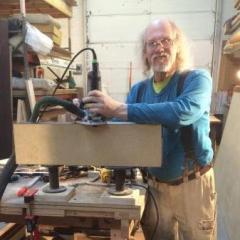-
Posts
1,880 -
Joined
-
Last visited
About CessnaPilotBarry
- Birthday July 30
Profile Information
-
Gender
Male
-
Location
Middletown, CT, USA
-
Woodworking Interests
Furniture and cabinetry construction, finishing, moonlight walks on the beach.
CessnaPilotBarry's Achievements
-
The Wave is a far better multi, it has more tools and theyre ll better quality. I'm sure the the TSA people who have three Waves I forgot were in my bag agree!
-
The soap issue was pretty bad...
-
I carry as little as possible. Normally, it's this knifeless mini-Leatherman:
-
I usually use a spiral upcut bit for almost everything except trimming tops. In the case of the hinge install, the hinge outline is knifed in, so the fibers are already cut. I like upcut bits where the bottom is closed, as they clear chips better, instead of jamming them down and burning them. The smaller the bit, as in the tiny bit mentioned in my previous post, the less chance of it tearing out the surface as it isn't grabbing huge sections of opposed grain. One thing I left out of the earlier post is to do the initial cuts where the bit is cutting on both sides in the center of the waste. Once that's done, you can decide which direction to move the router vs. the grain based on the cut quality you're seeing. If the bit tears anything out in the center, it's only waste that doesn't matter.
-
If you're not up on sharpening and using hand planes, there's a really safe way to do this with a trim router... Get a small, solid carbide spiral bit, like a 5 or 7/32". Small bits have very little torque, making the tool super easy to control freehand. Set the bit to exactly the hinge leaf thickness. Mark the hinge out with a knife as you would if you weren't using a router, slightly darken the lines with pencil if you need help seeing them. Clamp an extra board to the back edge to support the router base and prevent tipping. Thicker is better, as more support is provided. Freehand rout the waste, leaving ~ 1/16" near the lines. This will give you a perfectly flat bottom. Using the routed bottom as a reference for the flat chisel back, finish cutting to the knife lines with a sharp chisel. I like small ones here ~ 3/16 or 1/4", as if concentrates the force so you don't have to push as hard, limiting slip and damage potential. Once you get your router planes and technique up to snuff, you can also use them to finish the tiny amount left to remove. I own a full complement of router planes, etc... and I do this so often with a Rigid trim router, I leave the spiral bit installed. It's also a super way to waste out half blind dovetail sockets quickly, leaving the final angle cut and fitting to hand tools. Give it a try on scrap, you might be pleasantly surprised how easy and accurate this is!
-
I second this tip! It works great. I've used a combo square blade and a drafting triangle with excellent results.
-
As everything is a time / money tradeoff, I bought a ready to go 6CFM pump from Vacupress. Many of my accessories and supplies come from Joe, but I didn't build my own example of many of my tools. No matter how you get there, I can tell you that having a vacuum source in the shop is addictive. Once you find the biggest one you think you'll need, go one up... I'm using a lot more veneer than I thought I would, because I can and it makes great looking stuff!
-
I've used the jointer, table saw, and band saw. I prefer the table saw, with a good 20 tooth rip blade, for the fastest, most identical legs. Combo blades will often burn thick rips, thin blades may deflect, creating a curved definition from taper to flat. As for time spent making a jig... Remember, only people on the Internet spend many hours and dollars building pretty and widely adjustable infrequent use jigs. My taper jig is simply a 3/4" birch ply floor glued to a single 1/4" plywood runner, with the reference line created by a pass through the blade.. The cleats that locate the blanks are simply screwed in place using a mark on the first blank. Last, I screw two snap clamps to the floor. I think it took 20 minutes to make, including a coffee refill. Sometimes, I steal the clamps for other uses. For different tapers, I simply unscrew the clamps and cleats and move them... The reference line always stays the same, because the blade is always the same distance from the miter slot. Who cares if the jig looks like something from "Shop Notes", the output looks terrific! For more than two tapered sides, simply tape an offcut back on, appropriately located to account for the kerf. If anybody wants a picture, just let me know...
-
These are my current faves, with the optional Skull Screw foamies, in and around race cars, in the shop, and cutting grass. http://www.amazon.com/gp/product/B00AEY4QP2/ref=pd_lpo_sbs_dp_ss_1?pf_rd_p=1944687502&pf_rd_s=lpo-top-stripe-1&pf_rd_t=201&pf_rd_i=B001HVC8QU&pf_rd_m=ATVPDKIKX0DER&pf_rd_r=0YGYXHE6SHQYCJY67554 Plug whatever source you like into them, they block so much external noise, you'll find yourself turning the source down ridiculously low.
-
I've had baseboard hot water heat in various places all my life. I even make pretty wood covers for the registers. I don't like forced hot air heat at all... Don't worry about dust. Just vacuum or blow the baseboards out when you can remember. They don't get THAT hot. Plenty of dust bunnies, dog or cat toys, etc... will probably also end up in and under the registers. FWIW, here in the Northeast USA, many nicer homes use the air ducts only for air conditioning, with separate systems for cooling and and heating. Hydronic heat is very even and comfortable, silent, without warm / cool breeze cycling, and don't have the need to humidify forced air heat. Lots of homes use forced air heat combined with the a/c system, as it's cheaper than discrete systems, but having both is the kitty's buns...
-
If you delete stuff you needed, I'm sure the NSA can provide them later...
-
+1 on Horton Brasses... Truth in advertising - I know the owner and am local to Horton HQ, but that's NOT why I'm recommending them.
-
If my wife left that out in her classroom, it would get stolen... Veyr nice!
-
I cut straight tenon cheeks with a pair of matched rip blades, spacers, and a fence riding jig. I have spacers to match most of my HCM chisels. Everything references off one face, and it all works quite nicely. The spacers can be fine tuned with dado shims for other uses. Of course, I do this less and less since I bought a Domino last year. In the case of angled tenons, I'd immediately choose the Domino in any case I could. If you're going to do a lot of tablesawn tenons, the PM device looks very versatile.
-
FWIW, lifting aside, even 1300 pounds isn't as bad as you'd think. I know guys who move 2800-3400 pound race cars around the garage on Harbor Fright (sp intentional) wheel dollies all by themselves. Lifting is different, but across flat surfaces or CDX isn't as bad as it sounds.








